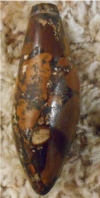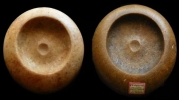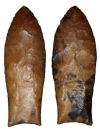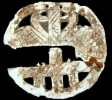|
See these, and more, in this issue of the Central States Archaeological Societies Journal

Click to enlarge |
This is what the owner calls the surprise plummet.
He acquired it along with three other plummets
at a recent show in Tupelo, Mississippi. When he
examined this one later that day, it was covered
with a lot of creek stain, but something seemed
to show underneath. He sat down and started
removing the surface patina, usually not a good
thing to do, but since it was the ugly “plummet”
of the four, he felt there was nothing to lose. After
an hour, it became an “ugly duckling” so to speak,
as the plummet turned out to be made from a
conglomerate material, and went from a dark ugly
thing to one of beauty. It measures 3 1//8 inches
long and most certainly unusual.
Collection of Frank Robison,
Hernando, Mississippi |

Click to enlarge |
Above are five colorful forelock beads from Tennessee and Kentucky. These are all highly polished and perforated, and the largest measures 1
1/8
inches
in
width.
These
beads
are
quite
rare
and
show
a
high
level
of
craftsmanship.
Note
how
similar
they
are
in
size
and
form,
but
vary
in
material
utilized.
These
are
Mississippian
in
time
frame
and
their
use
can
be
seen
in
human
portrayals
in
shell
and
copper from Spiro and other sites. |

Click to enlarge |
This well made Catahaula point was found on the surface by Greg Perino in Lamar County, Texas. It is pictured in his publication Selected
Preforms,
Points
and
Knives
of
the
North
American
Indians
Volume
1
on
page
70.
It
measures
1
½
inches
in
length
and
is
made
from
Ogallala
chert.
Note
how
the tip of the point utilizes
a spot of red
coloring in the material.
All of the above in the collection of Don and Diane Warmbrod, Cordova, Tennessee |

Click to enlarge |
Above are two magnificent double cupped “Tennessee-Style” Mississippian quartzite discoidials. Notice the similarity in size and quality
of
workmanship.
There
may
have
been
just
a
small
group
of
craftsmen
who
made
these
for
the
elite
or
for
various
communities.
A
discoidal
of
this
size
might
have
been
utilized
as
a
trade
item
or
gift
from
one
group
to
another.
Certainly
only
a
few
knew
the
secrets
to
producing
such
artistic
work,
and
there
must
have
been
a
guild
or
other
organization
that
passed
along
the
knowledge.
The
disc
at
the
left
measures
5
½
inches
in
width,
and
was
found
in
Hamilton
County,
Tennessee.
The
discoidal
on
the
right
was
found
near
Bridgeport
in
Jackson
County,
Alabama
and
measures
5
/14
inches
in
diameter.
Both
are
highly
polished
and
fit
the
hand
like
a
glove.
The
second
cup
would serve
to give
the thrower
more
control.
This style of disc is considered
to be the finest produced.
Collection of James and Elaine Kinker, Lake St. Louis, Missouri |

Click to enlarge |
This exceptionally fine and colorful Clovis point is made from
Coastal Plains chert and was found in an Alabama creek by the
owner several years ago. It is undamaged, has excellent flutes and
measures 3 ¼ inches in length.
Collection of Richard Reed, Eufaula, Alabama |

Click to enlarge |
This Hixon style shell gorget (also referred to as a Turkey-Cock) shows two birds confronting each other. A pole with scroll work
separates them in the middle and the pole forms part of a cross, with the lower portion most probably signifying water. Fenestrations
(cut-out) further enhance the artistic elements and there are two holes for suspension at the top. Although this gorget has suffered some
damage, these are very rare and seldom seen. It was found at the Tellico Site many years ago and measures 4 inches in width.
Collection of Mitchell Crisp, Cleveland, Tennessee
|
|
|




